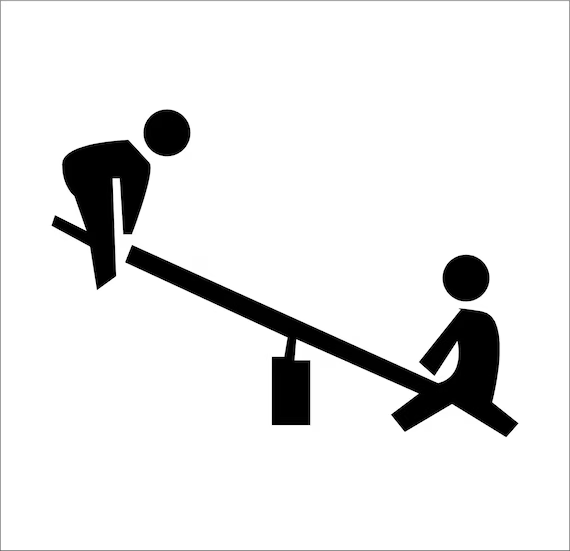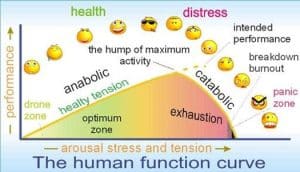Stress, Balance the Teeter Totter!
click here for pdf text version of newsletter.
One of the “ingredients” in my Recipe for Optimal Health is: Manage Your Stress Response. I love this topic because it really is about health, mindset, and habits all in one topic!
In this issue, I’ll cover a few basics about stress, but more importantly I want to share some tools to use preventively as well as in the moment to avoid ill effects of stress (so keep scrolling to the end!). Stress at times of course is appropriate, natural and necessary. If you step out to cross the street and see a car headed for you, it’s stress that pulls you out of harm’s way! But if you start expecting cars to come at you every time you go for a walk, and you become afraid to cross the street, it’s no longer helpful.

Many of us might define stress as:
- a state of mental or emotional strain or tension resulting from adverse or very demanding
- a feeling that people have when they are overloaded and struggling to cope with demands
More accurately stress is defined as:
- the body’s reaction to any change that requires an adjustment or response. The body reacts to these changes with physical, mental, and emotional responses.
I really like this illustration of how stress is good-up to a point. After a point of “too much”…intensity, duration, frequency-performance drops, well-being suffers and illness can eventually result.

I know-this probably isn’t big news…but when our brain perceives a stressor, hormones are released that effect tissues and organs all over our body. And when you effect one thing, well, everything is connected to everything else in our body-you effect the whole system (i.e.-you).
This stress response is involuntary-it just happens! It engages the autonomic nervous system-which consists of the following.
- The Enteric Nervous System (ENS)-there are a lot of neurons in the gut. Ever feel “butterflies in your stomach” or have a “gut feeling”?
- The Sympathetic Nervous System (SNS)-responsible for the fight, flight, freeze, fawn response. It activates in response to emotions such as anger, anxiety, worry, frustration, fear, excitement, competition, and sorrow.
- The Parasympathetic Nervous System (PNS)-the rest, digest, restore system. PNS activates in response to emotions such as peace, contentment, confidence, security, and harmony. Creates a healing, remission inducing state.
We are going to talk about SNS and PNS in this issue. Creating balance between these two systems is key. Like the teeter totter pictured above-when one is activated, the other is suppressed. At times we NEED one side of the teeter totter to be higher than the other. (remember playing on a teeter totter as a kid? I can remember pushing with my legs to shoot up, and try to bounce the person on the other end on the ground! Lol) But we want to be able to bring it back to balance readily.

This from Anxiety Centre is a really great overview of the stress response. Click here for the whole article.
Overall stress response body-wide changes:
- Heightens senses (sight, sound, smell, taste, and touch).
- The nervous system goes on high alert.
- The sympathetic nervous system suspends all nonessential bodily functions and increases activity in the areas of the body that are needed to fight or flee.
- Suppresses the immune system and pain response – to help reduce pain and swelling.
- Increases metabolism – so that we have the energy we need to fight or flee.
- Reduces insulin sensitivity.
- Suppresses the production of testosterone.
- Suppresses the growth system – a nonessential system when in danger.
- Increases blood clotting activity – to prevent unstoppable bleeding.
- Interferes with the onset and sustainability of the Sleep mechanism – so that we don’t fall asleep when fighting or fleeing.
Specific stress response body-wide changes:
- Increases activity in the amygdala and hippocampus, and suppresses prefrontal cortex – which heightens fear and memory storage, and reduces executive functions, such as rationalization.
- Increases a sense of danger – caused by the brain function changes above.
- Increases urgency to escape – caused by the brain function changes above.
- Dilates pupils – to take in enhanced visual information.
- Narrows peripheral vision (tunnel vision) – so we can focus on the threat without peripheral distractions.
- Inhibits the lacrimal gland – responsible for tear production and salivation, which helps increase visual perception and reduces digestion.
- Reduces hearing – so that the brain isn’t distracted and overwhelmed by extraneous auditory data.
- Tightens the body’s muscles – to make them more resistant to damage, to protect the underlying structures, and to increase reaction time.
- Increases perspiration – to eliminate the body’s water through the skin rather than through the kidneys (stopping to urinate when in a dangerous situation may impede or prevent escape).
- Causes goosebumps – Piloerector muscles cause shivers, “goosebumps,” and hair standing on end – to help maintain body temperature (constricted blood vessels and diverted blood cause the surface of the body to cool).
- Increases respiration – breathing increases (shallow and faster breathing) taking in more oxygen and eliminating the body’s increased waste products, which are being produced by the increased metabolism.
- Elevates heart rate – to pump the required oxygen and blood sugar-rich blood to the necessary body parts so that the body is ready to take action.
- Increases blood pressure – by contracting the muscular layer in the walls of the arteries to shunt blood away from and to parts of the body more vital to survival, and rushes blood to the muscles.
- Quickly converts the body’s storage of sugar (glycogen) and fats into usable energy – for the immediate production of energy at the cellular level.
- Increases blood sugar, oxygen, and blood flow to the brain.
- Inhibits digestion – the body only has so much blood so it shunts blood away from the digestive system and to the skeletal muscles so more of the body’s resources can be used for fighting or fleeing (the body can’t run both large systems at the same time so it diverts blood away from the digestive system to the more important system required for survival). Digestive system inhibition also decreases motility in the digestive tract and increases hydrochloric acid in the stomach to speed food through the digestive system.
- Tightens abdomen muscles – causing an urgency to urinate or void bowels to quickly eliminate any remaining food or waste from the body so that you don’t have to urinate or defecate while fighting or fleeing.
- Pancreas decreases insulin secretion – so that the body’s energy isn’t reduced.[26]
- Kidneys increase renin secretion – a hormone that regulates blood pressure and other physiological functions, such as cell growth and electrolyte balance.[14][15]
- Relaxes gallbladder.
- Contracts Sphincter muscles.
- Relaxes the bladder – so we don’t accidently urinate when we are fighting or fleeing.
- Suppresses sexual arousal.
It’s important to remember that the SNS becomes activated in response to a perceived threat or stimulus. It can be imagined or exaggerated-your brain doesn’t know the difference-it is reacting to your perception and reacts in proportion to that perception. The more of a threat you perceive, the more effect it has on your body.
While it might be difficult to ignore some of these body responses, it is very possible for you to experience a stress response in the body without knowing it. This is especially likely with chronic stressors.
When stress responses occur rarely, the body has sufficient time to recover and rebuild for the next stressful event. But when stress responses occur too frequently, the body doesn’t have sufficient time to recover. Consequently, it can enter into a state of stress-response hyperstimulation since stress hormones are stimulants. It’s like the teeter totter being stuck with one side up and the other down.

Hyperstimulation: elevated bp, chronic tension and pain, numbness/tingling other abnormal sensations, trembling/shaking, impairs homeostasis capacity so can affect any organ or system.
You can see how chronic SNS activation and hyperstimulation can lead to illness.
GOOD NEWS HERE-remember that teeter totter (how could your forget:) . Think of the SNS on one side and PNS on the other. If one is activated (up) the other is subdued (down). We can use this to our advantage! When we become aware of a stress response-we can counter that response and subdue it by activating the PNS.
First we need to notice a possible or likely stressor. Sometimes that seems like a no brainer, that we know when we are stressed…but we aren’t always aware. Sometimes you notice you are stressed after you become aware of body signals.
Stress signals:
- clenched hands
- sweaty palms
- rapid breathing
- tight shoulders
- frowning
- clenched jaw
- tight chest or belly
- hyper focused (not problem solving).
Next: Name it and Tame it
Once you notice it, name it-(lots of words are “stressful”). Here’s a thesaurus. Choose words that most accurately define your emotional/physical state) This shifts you from operating from the limbic system (emotional) to the rational/logical cerebral cortex. It shuts off (or dampens) the emotional and sympathetic response…shifts to PNS. Remember, when one is turned on the other is suppressed.
When you define or name your stress, you can take this opportunity to be more aware of what you are thinking about it. Our thoughts are merely OUR INTERPRETATION of reality, not reality itself. (2 people can describe the same situation in very different ways) Our thoughts are our brain’s reality-and the brain drives the body’s response. And our brain has an RAS-reticular activating system-our matchmaker in the brain. So it will look to match our experience with our thoughts.
Let’s do a little experiment!
Imagine: Open your fridge, pull out the fruit drawer. See a big yellow lemon there and take it out with your hand. Take it to your counter, grab a cutting board and a knife. Slice the lemon into wedges. Maybe some lemon juice squirts in your eye-yikes! You can smell the lemon, maybe it even stings a small cut on your hand. Now take a wedge and smell it, and take a big bite of it. …
When did your mouth start watering??? We were just THINKING about a lemon, right? And your body responded to those thoughts! We really are something else, aren’t we?

Our BODY responds to our thoughts and vise versa…because everything is connected to everything. -so we can also shift our bodily stress symptoms first, and allow our thoughts and emotions to follow. Remember, the brain response to our thoughts, whether what we are perceiving is real or imagined.
- Hands clenched-open and stretch the palm
- Frowning-turn the corners of your mouth up slightly
- Tight shoulders-pull them gently away from your ears
- Any area of tightness-breathe and soften (belly, low back, neck)
Engaging PNS helps you shift into problem solving/resolution. After naming your stress, consider:
- What outcome do you want?
- What do you need?
- How much control do you have? What are you choosing? What is mandated? It can be easier to accept temporary discomfort if you see it as a means to a desired end.
- What resources do I have?
- Health-resilience, energy
- Time-overwhelm is a choice (learn to prioritize, schedule and plan)
- Money-evaluate your resources, identify choices and supports
- Support-family, friends, mentors, ministers, benefits
- Habits- exercise can be a great way to “burn off” stress hormones and bring the body back into balance. Meditation, breathing exercises, connecting with people you care about. These are all habits we can establish.
Anxiety, or being stressed, or “hyped up” itself can become habitual.
Dr. Judson Brewer has done a lot of research and written several books on using mindfulness to change habits. Here is a recording of a great meditation for working with stress. It’s a 10 minute meditation. His website has lots of other great resources as well. He reports clients have had great success with developing awareness and curiosity around their anxiety and stress responses. Mindfulness is about non-judgement and curiosity-for example when you notice and name your stress-do so without trying to force an end to it, but to evaluate what YOU need, what is helpful or not, at that moment.
Other practices that can help you manage your stress response, to avoid that hyperstimulation, increase your resilience and quickness to recover from SNS activation and restore balance are:
- Identify your first next step…ask yourself “What is called for now?” You don’t have resolve everything all at once.
- Breathing! Check out this breath ball, super simple! You might want to bookmark it! https://youtu.be/KPP5iAGC4qE?si=JIdOYZddu2jhPqfj
- Alternate nostril breathing-here’s a quick video
- Use the 4 D system-do, dump, delegate, or delay (schedule it). Ask yourself, must I do this…and now? Can I do it later? Can I ask someone else to do it? Can I dump it?
- Check thoughts about a perceived stressor (person, situation, task…)-would the majority of people agree/concur? Is there any evidence to the contrary? Watch for words you might use like always, never everyone, nobody. Absolutes are rarely absolutely true.
- Lower your emotional temperature. Imagine a thermometer, with higher stress levels getting a higher temp reading. Know your starting “temp” then try to lower it just a few degrees at a time. Try this tool.
- EFT(Emotional Freedom Technique) or “tapping: Many people find this practice helpful. It is a very simple practice to do and works on principles of acupressure, where you gently press or tap at specified points. I like that the process has you “score” your state before and after so you can have an objective sense of whether it is helpful for you. Some consider it “woo woo”, and there isn’t a lot of academic research on it. But it’s a low risk practice, and can be as cheap as free. I like to have lots of “tools in my toolbox” Here is a demo from a continuing ed course I took.
- Practice self-compassion, self-acceptance as you are (weight, bad habits, warts and all!). You deserve it!
- Vagus nerve stimulation-I attended a great class on stimulating the ventral vagus nerve to enhance the PNS. One surprising tool was cold water immersion (cold shower, face splashing), humming was another-there are many more! There is a lot of information and resources out there about “polyvagal theory” so if that interests you I encourage you to check them out! Here is a demonstration of an exercise for the vagus for anxiety. A book you might check out is Accessing the Power of the Vagus Nerve by Stanley Rosenberg is easy to read also.
Other Tools That Have Some Cost
1. Counseling or Therapy -If you feel like you need help, that your stress or anxiety are overwhelming for you, reach out for it! Cognitive Behavioral Therapy is an excellent type of therapy that helps you recognize, choose and change your thoughts. CBT usually does not rely on medications but instead empowers you.
2. Coaching-if you feel like you need help to change your “stress habit” or to learn new self-care habits, a coach can help with that! If you want to talk with me about how coaching could work for you, book a discovery session here.
3, Get help from appropriate professionals to resolve issues that are creating stress.
- pain
- health
- financial
- relationship
- career
4. MELT Method– …gentle massaging techniques used along with soft tools increase fluid flow through the hands and feet to the whole body’s connective tissue (fascia), thereby creating a chain reaction and reducing pain, stiffness, stress and tension. (www.meltmethod.com) Here is a MELT sequence for stress and tension.
This translates to PNS stimulation-a healing state, and when PNS is activated, SNS is subdued. Remember the body impacts the mind and vice-versa. I use MELT myself and I love it.
I hope I was able to share some new thoughts, resources or tools to help you appreciate the highs and the lows on that teeter totter, but to know how to return to balance when you need that too.

Mindset Matters Most
We can get stressed about being stressed! In this clip Dr. Alia Crum (who has done tons of mindset research!) shares a neat experiment proving the power of mindset in regards to stress and whether or not it is helpful or harmful.
Coaches Corner
Choose one of the tools/suggestions in this newsletter. Set a SMART goal around it. This tool might be helpful.
- What specifically will you do. When, how often, for how long, where, with whom.
- How will you remember to do it?
- How will you track that you did it?
- How and when will you evaluate how you did?
- After you are successful, what might you do next?
…use it-see what happens. (try to document for a week or two) I’d love to hear how it goes!

Recent Comments